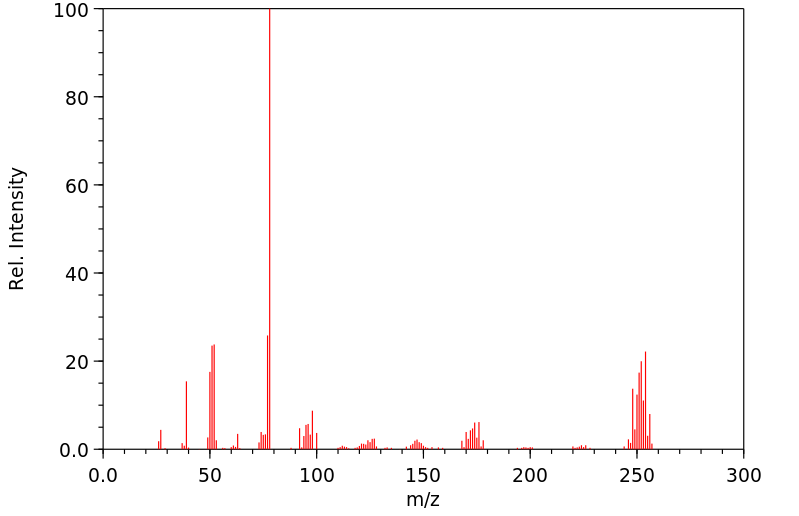bis(benzene)molybdenum | 12129-68-9
中文名称
——
中文别名
——
英文名称
bis(benzene)molybdenum
英文别名
bis(benzene)molybdenum(0);Mo(benzene)2;Mo bis(benzene)2;Benzene;cyclohexane;molybdenum;benzene;molybdenum
CAS
12129-68-9
化学式
C12H12Mo
mdl
——
分子量
252.167
InChiKey
KXKURNTZDRVLAJ-UHFFFAOYSA-N
BEILSTEIN
——
EINECS
——
-
物化性质
-
计算性质
-
ADMET
-
安全信息
-
SDS
-
制备方法与用途
-
上下游信息
-
文献信息
-
表征谱图
-
同类化合物
-
相关功能分类
-
相关结构分类
计算性质
-
辛醇/水分配系数(LogP):3.37
-
重原子数:13
-
可旋转键数:0
-
环数:2.0
-
sp3杂化的碳原子比例:0.0
-
拓扑面积:0
-
氢给体数:0
-
氢受体数:0
SDS
反应信息
-
作为反应物:参考文献:名称:Eine neue Wertigkeitsstufe des Technetiums摘要:DOI:10.1007/bf00590376
-
作为产物:描述:[Mo(η6-C6H5Li)2]*tmeda 在 Cl2Si(CH3)CH(CH3)2 作用下, 生成 bis(benzene)molybdenum参考文献:名称:双(苯)钼的二锂化和随后分离含钼的对环芳烷摘要:在存在 N,N,N',N'-四甲基乙二胺(每种最多 6 equiv)的情况下,通过使用过量的 BuLi 成功地二锂化了均质夹心复合物双(苯)钼 [Mo(eta6-C6H6)2] ) 在稍微升高的温度下以高产率提供高反应性的环金属化物质 [Mo(eta6-C6H5Li)2].tmeda。或者,该化合物是在不加热的情况下用 5 当量的 tBuLi/tmeda 在长时间超声处理后合成的。X 射线晶体结构测定揭示了固态的对称二聚体组成,即 [Mo(eta6-C6H5Li)2]2.(thf)6 的分子式,其中六元环由两对连接桥接锂原子。由于所得化合物的热不稳定性,在 [1]bora 和 [1]sila 桥的情况下,难以合成的 ansa 桥接复合物的合成失败。相反,将二锂前体反向添加到过量的适当元素二卤化物中促进了几种无应变的 1,1'-二取代衍生物的分离,即 [Mo{eta6-C6H5(BN(SiMe3)2X)}2](DOI:10.1021/ja0692130
-
作为试剂:描述:2-(4-甲氧基苯基)吡啶 在 叔丁基过氧化氢 、 正丁基锂 、 bis(benzene)molybdenum 、 diethylzinc 、 palladium diacetate 、 菲醌 、 三氟乙酸 作用下, 以 四氢呋喃 、 癸烷 、 正己烷 、 二氯甲烷 、 均三甲苯 为溶剂, 反应 104.83h, 生成 8-methoxy-6-phenylpyrido[2,1-a]isoindole参考文献:名称:使用环丙烷作为 C1 合成单元,通过定向逆环丙烷反应释放乙烯摘要:烯烃的环丙烷化是用于合成环丙烷的成熟教科书反应,其中利用“高能”卡宾物种来推动反应向前发展。然而,很少有人关注涉及逆反应、逆环丙烷化 (RC) 的分子转化。这是因为与切割两个孪生 CC 单键和利用生成的卡宾以有效和选择性的方式进一步转化相关的困难。在这里,我们报告了基于钼的催化系统克服了上述挑战,并通过释放乙烯(烯烃)和随后的分子内环化作用产生吡啶并 [2,1-a] 异吲哚,从而影响带有吡啶基的环丙烷的 RC。与使用环丙烷作为 C3 合成单元的大多数常规反应相比,该反应允许不常见地使用环丙烷作为 C1 合成单元。我们预计这一新策略将为 C1 环丙烷化学铺平道路。DOI:10.1021/jacs.8b09297
文献信息
-
Synthesis and polymerisation of bis(η-styrene)molybdenum and related studies: crystal structures of Mo(η-C6H5CH2CHCH2)2 and [Mo(η-C6H5SiMe2H)2]BF4作者:M.L.H. Green、I. Treurnicht、J.A. Bandy、A. Gourdon、K. ProutDOI:10.1016/s0022-328x(00)99703-1日期:1986.5The synthesis of the compounds Mo(η-C6H5R)2, where R CHCH2, 4-C5H4CHCH2 and CH2CHCH2 is described. The crystal structure of Mo(η-C6H5CH2CHCH2)2 has been determined. These vinyl monomers are polymerised by free radical initiation using AIBN. Di-η-benzenemolybdenum is lithiated by BunLi/Me2NCH2CH2NMe2 to give a bis(η-lithiobenzene)molybdenum derivative, which reacts with D2O, MeI, or SiMe3Cl to的合成化合物的Mo(η-C 6 H ^ 5 R)2,其中RCHCH 2,4-C 5 H ^ 4 CHCH 2和CH 2 CHCH 2进行说明。沫的晶体结构(η-C 6 H ^ 5 CH 2 CHCH 2)2已被确定。这些乙烯基单体通过使用AIBN的自由基引发而聚合。二丁基苯钼被Bu n Li / Me 2 NCH 2 CH 2 NMe 2锂化得到双(η-硫代苯)钼衍生物,其与D 2 O,MeI或SiMe 3 Cl反应得到Mo(η- C6 H 5 R)2,其中R分别为D,Me或SiMe 3。与森达二锂发生反应系统2氯,得到含有氯森达聚合物混合物2 -η-C 6 H ^ 5的Mo-η-C 6 H ^ 5 } Ñ森达2这产生二硅氧烷沫的Cl和水解(η- ç 6 ħ 5森达2 OSiMe 2 -η-C 6 H ^ 5),其晶体结构已确定。钼原子与二甲基苯基硅烷的共缩合得到Mo(η- C6
-
Photoinduced hydrogen–deuterium exchange between aromatic and aliphatic hydrocarbon systems catalysed by [Mo(η-C<sub>5</sub>H<sub>5</sub>)(Me<sub>2</sub>PCH<sub>2</sub>CH<sub>2</sub>PMe<sub>2</sub>)H<sub>3</sub>]作者:Peter D. Grebenik、Malcolm L. H. Green、Alejandro IzquierdoDOI:10.1039/c39810000186日期:——deuteriobenzene solutions of hydrocarbons such as p-xylene and ethylbenzene, dimethyl ether, or p-methyllanisole, in the presence of [Mo(η-C5H5)(Me2PCH2CH2PMe2)H3], causes the statistical exchange of all or many of the hydrogens with deuterium; the hydrogens of co-ordinated hydrocarbon ligands of ferrocene and bis-η-toluenetungsten and other organometallic compounds are similarly exchanged.
-
Stereoelectronic Factors That Influence Kinetic and Thermodynamic Sites of Protonation of (η<sup>6</sup>-Arene)molybdenum(phosphine)<sub>3</sub> Complexes作者:Michael T. Ashby、Victor S. Asirvatham、Angela S. Kowalski、Masood A. KhanDOI:10.1021/om990281n日期:1999.11.1We have previously reported (J. Am. Chem. Soc. 1995, 117, 12639) the arene complex (η6-C6H6)Mo(TRIPOD) (1), where TRIPOD = 1,1,1-tris(diphenylphosphinomethyl)ethane, is protonated upon addition of 1 equiv of D+ to yield the metal−hydride [(η6-C6H5D)Mo(TRIPOD)H]+ (1H+-d1) via exo addition of D+ to the arene ligand followed by migration to the metal of the endo proton of the putative η5-cyclohexadienyl我们以前曾报道(J.化学会会志。 1995,117,12639)的芳烃络合物(η 6 -C 6 H ^ 6)的Mo(三脚架)(1),其中TRIPOD = 1,1,1-三(二苯基膦甲基)乙烷,是在加入1个当量的d的质子+,得到金属-氢化物[(η 6 -C 6 H ^ 5 d)的Mo(三脚架)H] +(1H +-d 1)通过外切加成d的+向芳烃配体,随后迁移到所述的金属内的质子的推定η 5 -cyclohexadienyl络合物[(η 5 -C 6 ħ 6 d)的Mo(三脚架)] +(1 ‡)。相反同位素时获得(η 6 -C 6 d 6)钼(三脚架)(1-d 6)被用来得到[(η 6 -C 6 d 5 1H)沫(三脚架)d] +(1D +-d 6)。我们最近的电子结构的调查1和它的单电子氧化的衍生物[(η 6 -C 6 H ^ 6)的Mo(三脚架)] +(1 +)暗示质子化机制并非完全由电子因素驱动;
-
Electronic absorption spectra of molybdenum(0) bisarene complexes, (η6-Arene)2Mo0作者:S.Yu. Ketkov、G.A. DomrachevDOI:10.1016/0022-328x(90)85410-z日期:1990.6The UV and visible absorption spectra of (η6-Arene)2Mo0 (Arene = benzene (I), toluene (II), m-xylene (III), mesitylene (IV)) in the vapor phase and in the pentane solution have been investigated. Rydberg series converging to the ionization limit have been found in the spectra of vaporous complexes. The sharpest Rydberg bands correspond to the transitions 4d(a1g) → Rnp(e1u) and 4d(a1g) → Rnp(a2u). The的(ηUV和可见吸收光谱6 -Arene)2沫0(芳烃=苯(I),甲苯(II),米在气相中和在戊烷溶液二甲苯(III),三甲苯(IV))已被调查。在蒸气络合物的光谱中发现了收敛到电离极限的里德伯格级数。最锐利的Rydberg谱带对应于跃迁4 d(a 1 g)→ Rnp(e 1 u)和4 d(a 1 g)→ Rnp(a 2 u)。乐队从4d(a 1 g)→ R 5 s(a 1 g)Rydberg跃迁已在II和III配合物的气相光谱中发现。气相光谱中的一些弱谱带已被暂时指定为4 d(a 1 g)→ Rnd跃迁。从气相到戊烷溶液时,Rydberg能带从光谱中消失了。I–IV的电离极限分别为5.525±0.010、5.375±0.010、5.250±0.010、5.137±0.010 eV。这些限制对应于最高占据分子轨道4 d(a 1g),并且与通过光电子能谱法测定的配合物I,II和IV的第一电离电位一致。
-
Synthesis, reactions, and crystal structures of cyclo-η<sup>5</sup>-[1-(disubstituted methyl)cyclopentadienyl](η-arene)-molybdenum and -tungsten compounds作者:Malcolm L. H. Green、Alejandro Izquierdo、Jesus J. Martin-Polo、Victor S. B. Mtetwa、Keith ProutDOI:10.1039/c39830000538日期:——arene rings of W(η-C6H5Me)2 and Mo(η-C6H6)2 are readily displaced by the fulvenes C5H4CR2(R = Me or Ph) giving M(η5:η1-C5H4-µ-CR2)(η-arene), M = Mo or W; when M = Mo and R = Me then treatment with HCl gives the binuclear [Mo(η-PriC5H4)(µ-Cl2)]2 whose crystal structure has been determined and which is a convenient precursor to mono-cyclopentadienylmolybdenum derivatives.
表征谱图
-
氢谱1HNMR
-
质谱MS
-
碳谱13CNMR
-
红外IR
-
拉曼Raman
-
峰位数据
-
峰位匹配
-
表征信息
同类化合物
(βS)-β-氨基-4-(4-羟基苯氧基)-3,5-二碘苯甲丙醇
(S,S)-邻甲苯基-DIPAMP
(S)-(-)-7'-〔4(S)-(苄基)恶唑-2-基]-7-二(3,5-二-叔丁基苯基)膦基-2,2',3,3'-四氢-1,1-螺二氢茚
(S)-盐酸沙丁胺醇
(S)-3-(叔丁基)-4-(2,6-二甲氧基苯基)-2,3-二氢苯并[d][1,3]氧磷杂环戊二烯
(S)-2,2'-双[双(3,5-三氟甲基苯基)膦基]-4,4',6,6'-四甲氧基联苯
(S)-1-[3,5-双(三氟甲基)苯基]-3-[1-(二甲基氨基)-3-甲基丁烷-2-基]硫脲
(R)富马酸托特罗定
(R)-(-)-盐酸尼古地平
(R)-(-)-4,12-双(二苯基膦基)[2.2]对环芳烷(1,5环辛二烯)铑(I)四氟硼酸盐
(R)-(+)-7-双(3,5-二叔丁基苯基)膦基7''-[((6-甲基吡啶-2-基甲基)氨基]-2,2'',3,3''-四氢-1,1''-螺双茚满
(R)-(+)-7-双(3,5-二叔丁基苯基)膦基7''-[(4-叔丁基吡啶-2-基甲基)氨基]-2,2'',3,3''-四氢-1,1''-螺双茚满
(R)-(+)-7-双(3,5-二叔丁基苯基)膦基7''-[(3-甲基吡啶-2-基甲基)氨基]-2,2'',3,3''-四氢-1,1''-螺双茚满
(R)-(+)-4,7-双(3,5-二-叔丁基苯基)膦基-7“-[(吡啶-2-基甲基)氨基]-2,2”,3,3'-四氢1,1'-螺二茚满
(R)-3-(叔丁基)-4-(2,6-二苯氧基苯基)-2,3-二氢苯并[d][1,3]氧杂磷杂环戊烯
(R)-2-[((二苯基膦基)甲基]吡咯烷
(R)-1-[3,5-双(三氟甲基)苯基]-3-[1-(二甲基氨基)-3-甲基丁烷-2-基]硫脲
(N-(4-甲氧基苯基)-N-甲基-3-(1-哌啶基)丙-2-烯酰胺)
(5-溴-2-羟基苯基)-4-氯苯甲酮
(5-溴-2-氯苯基)(4-羟基苯基)甲酮
(5-氧代-3-苯基-2,5-二氢-1,2,3,4-oxatriazol-3-鎓)
(4S,5R)-4-甲基-5-苯基-1,2,3-氧代噻唑烷-2,2-二氧化物-3-羧酸叔丁酯
(4S,4''S)-2,2''-亚环戊基双[4,5-二氢-4-(苯甲基)恶唑]
(4-溴苯基)-[2-氟-4-[6-[甲基(丙-2-烯基)氨基]己氧基]苯基]甲酮
(4-丁氧基苯甲基)三苯基溴化磷
(3aR,8aR)-(-)-4,4,8,8-四(3,5-二甲基苯基)四氢-2,2-二甲基-6-苯基-1,3-二氧戊环[4,5-e]二恶唑磷
(3aR,6aS)-5-氧代六氢环戊基[c]吡咯-2(1H)-羧酸酯
(2Z)-3-[[(4-氯苯基)氨基]-2-氰基丙烯酸乙酯
(2S,3S,5S)-5-(叔丁氧基甲酰氨基)-2-(N-5-噻唑基-甲氧羰基)氨基-1,6-二苯基-3-羟基己烷
(2S,2''S,3S,3''S)-3,3''-二叔丁基-4,4''-双(2,6-二甲氧基苯基)-2,2'',3,3''-四氢-2,2''-联苯并[d][1,3]氧杂磷杂戊环
(2S)-(-)-2-{[[[[3,5-双(氟代甲基)苯基]氨基]硫代甲基]氨基}-N-(二苯基甲基)-N,3,3-三甲基丁酰胺
(2S)-2-[[[[[((1S,2S)-2-氨基环己基]氨基]硫代甲基]氨基]-N-(二苯甲基)-N,3,3-三甲基丁酰胺
(2S)-2-[[[[[[((1R,2R)-2-氨基环己基]氨基]硫代甲基]氨基]-N-(二苯甲基)-N,3,3-三甲基丁酰胺
(2-硝基苯基)磷酸三酰胺
(2,6-二氯苯基)乙酰氯
(2,3-二甲氧基-5-甲基苯基)硼酸
(1S,2S,3S,5S)-5-叠氮基-3-(苯基甲氧基)-2-[(苯基甲氧基)甲基]环戊醇
(1S,2S,3R,5R)-2-(苄氧基)甲基-6-氧杂双环[3.1.0]己-3-醇
(1-(4-氟苯基)环丙基)甲胺盐酸盐
(1-(3-溴苯基)环丁基)甲胺盐酸盐
(1-(2-氯苯基)环丁基)甲胺盐酸盐
(1-(2-氟苯基)环丙基)甲胺盐酸盐
(1-(2,6-二氟苯基)环丙基)甲胺盐酸盐
(-)-去甲基西布曲明
龙蒿油
龙胆酸钠
龙胆酸叔丁酯
龙胆酸
龙胆紫-d6
龙胆紫







